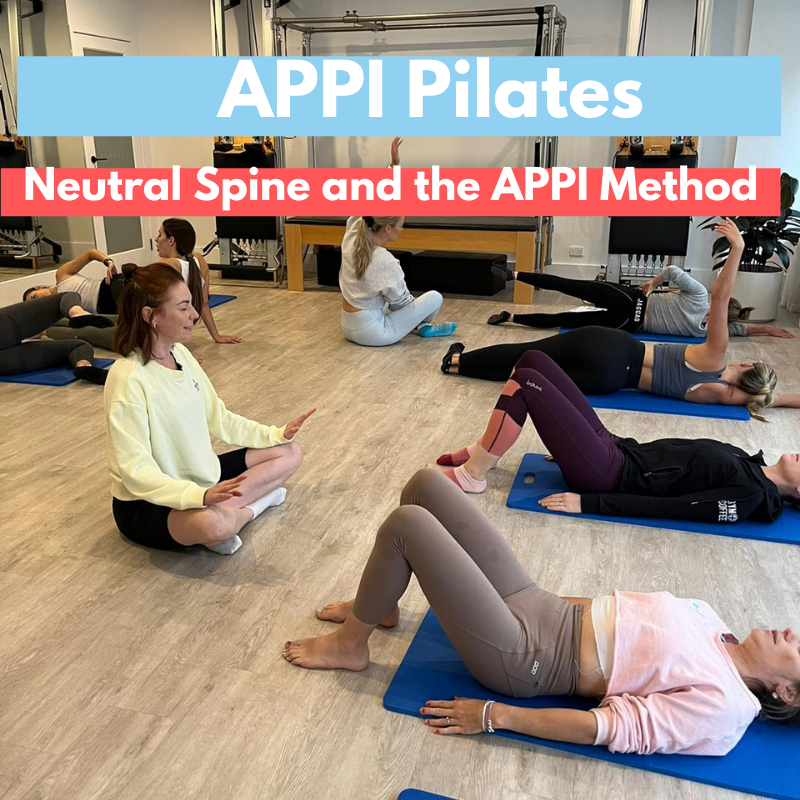APPI 5 key Pilates Elements
Pilates has long been considered the exercise of choice for many when wanting to improve posture and core activation or reduce low back pain.
One of the first things taught in Pilates is neutral spine. Neutral spine is the position achieved when the spine is aligned correctly, with no twists or bends. It requires the least amount of energy and therefore the posture should be able to be sustained with minimal effort.
Sounds good in theory, but we all know how tiring it can be to stand or sit up straight for a prolonged time. Years of sitting, carrying children, repetitive lifting or whatever it is you do in your life, has caused most of us to lose our ability to stand in neutral spine easily. Welcome Pilates!
The teaching of neutral spine is steeped in the historic nature of Pilates. After all, one of founder Joseph Pilates’ eight key principles of Pilates is Alignment. But why is neutral spine so important? Specifically, in Pilates, we know that performing exercises in neutral spine reduces the load on certain muscle groups and lowers the risk of low back pain (Shahet al, 2021). Outside of Pilates, a study last year found that in order to improve lumbar load distribution and minimise fatigue during lifting, a more neutral posture (neither too lordotic nor kyphotic) was recommended (Khoddam-Khorasani et al, 2020).
The APPI’s five key elements are designed to teach neutral spine, along with core activation and breathing, and are the foundation of our teaching method. We know that with neutral spine comes improved core activation, which is why we teach them hand-in-hand. Our deeper abdominal muscles (transvers abdominis) and our pelvic floor are more easily recruited when our spine is held in neutral. Thus, this is a fantastic position to begin learning the correct activation and recruitment of these muscles.
These muscles play an important role in warding of nasties like back pain. In fact, it’s been found that people with low back pain have a significant reduction in their activation of these muscles (Mansuri & Shah, 2017) and that motor control training with a focus on transverse abdominis activation reduces pain and disability in people with low back pain (Shanbehzadeh et al, 2021).
OUR CLINICAL PILATES INSTRUCTOR COURSES ARE DESIGNED BY PHYSIOTHERAPISTS SPECIFICALLY FOR ALLIED HEALTH PROFESSIONALS
Our certified clinical Pilates course has a trusted repertoire of exercises, with safety and rehabilitation at the forefront of each exercise. The APPI program has been running since 2000, and it is because of its success and popularity, that it is now offered in over 24 countries internationally. If you complete the APPI Clinical Pilates Certification, you will be amongst a huge community of like-minded health professionals, which can open up a world of networking and professional opportunities.
- - - -
Khoddam-Khorasani. P., Arjmand. N., & Shirazi-Adl. A. (2020). Effect of changes in the lumbar posture in lifting on trunk muscles and spinal loads: A combined in vivo, musculoskeletal, and finite element model study. Journal of Biomechanics. https://www.sciencedirect.com/science/article/abs/pii/S0021929020301445? casa_token=5PInYYjsc0UAAAAA:7QJ467Ze2OxKWRxtP4Gxqc
oP-u7i8GnipnXy4k3O1IXCYM3XV5qKzu2Drv1JcdIckzeRB3I_
Mansuri. F., & Shah. N. (2017). Comparison of Core Muscles Activation and Endurance in Asymptomatic and Patients with Low Back Pain. International Jornal of Therapies and Rehabilitation Research. 6(2): 234-240. https://www.proquest.com/docview/1911205938?pq-origsite=gscholar&fromopenview=true
Shah. J., Tanwar. T., Iram. I., Aldabbas. M., & Veqar. Z. (2020). Effect of Increased Lumbar Lordosis on Lumbar Multifidus and Longissimus Thoracis Activation during Quadraped Exercise in Patients with Chronic Low Back Pain: An EMG Study. Journal of Applied Biomechanics. 36(6): 436-443. https://journals.humankinetics.com/view/journals/jab/36/6/article-p436.xml
Shanbehzadeh. S., ShahAli. S., Hides. J., Ebrahimi-Takamjani. I., & Rasouli. O. (2021). Changes in Morphometry of Trunk Muscles, Pain and Disability Associated with Motor Control Training in People with Chronic Low Back Pain: a Systematic Review and Meta-Analysis. Research
Square. https://assets.researchsquare.com/files/rs-706368/v1/5439510c-a9af-4dc9-adf8-b78898259db4.pdf?c=1626362064
